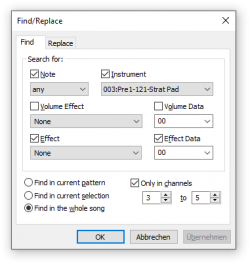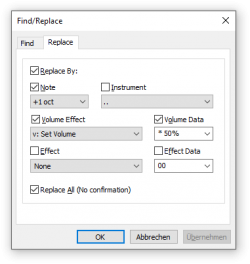Manual: Find and Replace

The Find Page[edit]
You can search for the data that meets the criteria you enumerate below, starting where the cursor is in the Pattern Editor. After you enable at least one of the search criteria and fill in the required target data, you can press OK and the search begins in the location you specify in the Search Range limits at the bottom of the page. The search starts in the first row and checks each channel, then proceeds to the next row after all channels in the range have been searched. If an instance that meets the criteria is found, the cursor is positioned there and the field is highlighted.
You can continue searching using the Find Next command (in the Edit Menu or its keyboard shortcut), even after editing the highlighted data. The search continues from the current cursor position.
- Search for Note: Checking the box will use the note criteria as part of the search query. Clicking on the field below it shows a popup menu where you can choose a note range (“any” will match any musical notes, but not Note Cut / Note Fade / etc.), a particular note, or a note message (like Note Cut) to search for. Parameter Control Events are considered note messages and can be queried here.
- Search for Instrument: Checking this box will include the instrument criteria in the search query. Clicking on the field below it shows a popup menu where you can choose a particular instrument or instrument range to search for. When searching for Parameter Control events, this field lets you search for the plugin entry.
- Search for Volume Column Effect: Checking this box will include the volum column effect criteria in the search query. Clicking on the field below it shows a popup menu where you can choose a particular volume column command to search for. The available commands depends on the track type.
- Search for Volume Column Parameter: Checking this box will include the volume column parameter criteria in the search query. Clicking on the field below it shows a popup menu where you can choose a value or range to search for.
- Search for Effect Column Effect: Checking this box will include the effect column effect criteria in the search query. Clicking on the field below it shows a popup menu where you can choose the command to search for. The available commands depends on the track type.
- Search for Effect Column Parameter: Checking this box will include the effect column parameter criteria in the search query. Clicking on the field below it shows a popup menu where you can choose a value or range to search for.
- Search Range: The last two items define the range where you can execute the search. Click on a radio button to conduct a search either only in the current pattern, the current selection, or in all patterns. If you want to narrow the search to only one or more contiguous channels, check the box and fill in the range of channels.

The Replace Page[edit]
You can also choose to have certain data replaced along the way, which saves time instead of entering the data yourself. To do a Find & Replace, enter the Find criteria on the first page, then chose some values to replace with in this page:
- An absolute amount (always available).
- Arithmetics: Addition (adding or subtracting a fixed amount to the found value) — available for all columns but command letters.
- Arithmetics: Multiplication (multiply found value with a fixed percentage) — only available for parameter columns.
The “Replace By” box is then checked automatically when changing the amount. It is not necessary to replace the same kind of data that was sought for; For example you could do a search for all Note Fades, and in each instance where one is found, you could use Replace to enter a volume effect without deleting the Note Fade.
To use Replace, enable the checkbox for each data item type and choose the correct data to be entered. Before clicking OK, make sure the Replace All box is checked for a complete search-and-replace (it is set by default); if the check box is not activated, you will be prompted each time the Find routine locates the target data, and you can choose to replace it one-by-one.
When the Replace function is executed, an Undo step is created, so you can undo your changes if you need to. Replacing one-by-one (the Replace All is not set) enters each replacement normally into the Undo memory, but when you use the Replace All option, all replacements are entered as one step, so that using Undo will delete the entire set of modifications made by this dialog.